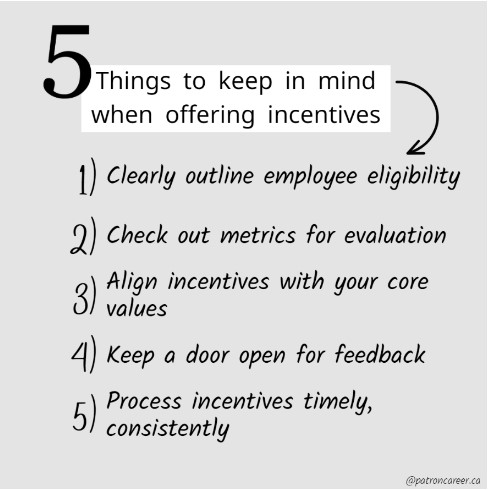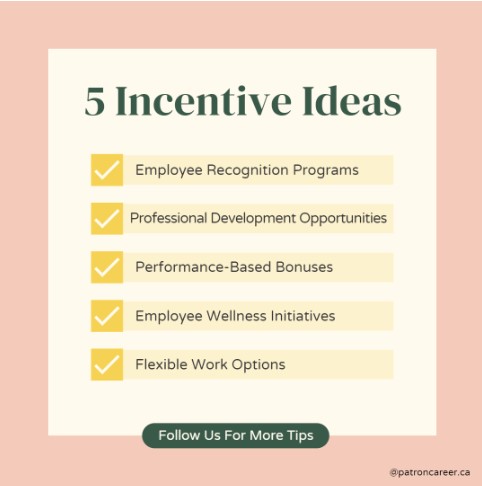
Innovation in the Workplace
12 June, 2023
Patron Career Staffing firmly believes in adopting a tailored approach to meet temporary and permanent recruitment needs. We safeguard the interest of our clients by finding such workers who are knowledgeable and reliable.
About UsNeed help? Make a Call
32 Dundas Street East Unit A, L5A1W2

It is without a doubt crucial for companies looking to foster innovation, motivation and engagement in their organisation to constantly reward and recognize employee efforts for a more positive work culture. Reassessing current compensation and benefits provided to employees is equally important to avoid a lackadaisical environment and reduce attrition rates. The ROI of employee incentives is great, allowing you to revamp your competitive advantage in the market.
Keep reading this blog to understand the effective motivation tools you can use to encourage employees to perform their best. Let us discuss in detail the meaning, significance, types and benefits of employee incentives along with some ideas to inspire motivation in your workforce.
Meaning and Significance of Employee Incentives
Employee incentives, also known as fringe benefits are numerous types of rewards, recognition and perks that companies provide their employees to maintain retention and attract talent. These are stellar recognition tools for acknowledging performance, teamwork, achievements, and contributions of employees towards organizational success.

Without them, several negative effects linger over the company and its workforce, such as:
The significance attached to consistent employee incentives lies in their ability to:
. Supercharge motivation: incentives, which act as tangible rewards have a positive influence on the employee. They boost them to go the extra mile and keep working hard to attain all personal and professional goals.
. Enhance engagement: incentives foster positive and rewarding work culture, leading to employee satisfaction, engagement, and a sense of belonging.
. Improve retention: retention is challenging, but with constant recognition and rewards companies can boost retention rates, and reduce turnover and related costs.

Types of Employee Incentives
1. Monetary Incentives: These incentives are financial ones providing immediate gratification and are highly effective in motivating employees to achieve specific targets or goals. Some of its types are:
. Cash Bonuses: Employees receive a one-time cash reward based on their performance, achievement of targets, or exceptional contributions.
. Profit Sharing: Employees are eligible to receive a portion of the company's profits, usually distributed annually or quarterly.
. Commission: Sales-oriented roles may receive a commission based on the sales they generate.
. Salary Increases: Employees may receive raises or salary adjustments based on their performance or tenure with the organization.
2. Non-Monetary Incentives: TNon-monetary incentives are another common form of incentives that focus on recognition, perks, and benefits. Non-monetary incentives enhance employee satisfaction, work-life balance, and personal growth.
. Employee of the Month/Year Awards: Recognizing outstanding employees through awards, certificates, or public recognition.
. Flexible Work Schedules: Allowing employees to have control over their work hours or providing options such as remote work or compressed workweeks.
. Extra Vacation Days: Granting additional paid time off as a reward for exceptional performance or years of service.
. Training and Development Opportunities: Offering opportunities for employees to enhance their skills, attend workshops, conferences, or pursue higher education.
. Company-Sponsored Events: Organizing team-building activities, retreats, or social events to foster camaraderie and positive work culture.
3. Performance-Based Incentives: These incentives are directly linked to an employee's performance and achievements. Following are examples:
. Performance-Based Bonuses: Employees receive financial rewards based on meeting or exceeding specific performance targets or key performance indicators (KPIs).
. Stock Options: Offering employees the opportunity to purchase company stocks at a discounted rate or as part of their compensation package.
. Promotions: Recognizing exceptional performance by promoting employees to higher-level positions with increased responsibilities and benefits.
Related: A COMPLETE GUIDE TO PERFORMANCE APPRAISALS
4. Team-Based Incentives: These incentives promote collaboration and team effectiveness . They focus on rewarding teams for achieving collective goals. Team-based incentives inspire collaboration, foster a sense of camaraderie, and drive collective success.
. Team Recognition Events: Celebrating team accomplishments through special events, outings, or team-building activities.
. Team Performance Bonuses: Providing financial rewards to teams that meet or exceed predefined targets or objectives.
. Profit-Sharing among Teams: Allocating a portion of the company's profits to be shared among teams based on their contributions.
5. Intrinsic Incentives: TIntrinsic incentives focus on internal motivators such as meaningful work, autonomy, and professional growth. These originate inside the individual's mind and body receiving the incentive. Such employee incentives tap into employees' intrinsic motivations and provide opportunities for personal growth, autonomy, and meaningful work. Examples include:
. Challenging Projects: Assigning employees stimulating and challenging projects that allow them to utilize and develop their skills.
. Skill Development Opportunities: Offering training, mentoring programs, or cross-functional projects that enable employees to learn new skills and expand their expertise.
. Clear Career Paths: Providing a clear progression plan and opportunities for advancement within the organization, giving employees a sense of direction and growth.
Companies should inculcate the habit of utilizing a combination of these employee incentives. They are beneficial and can cater to the diverse needs and preferences of their employees, ensuring a well-rounded and impactful ncentive program. i
Let’s look at some of the important benefits that employee incentives provide:
1. Increased Productivity: Incentivized employees are motivated to work harder, leading to increased productivity and better outcomes for the organization.
2. Enhanced Job Satisfaction: Employee incentives contribute to higher job engagement and satisfaction levels by recognizing and appreciating employees' efforts, which leads to a positive work environment.
3. Improved Employee Retention: By acknowledging and rewarding employees, organizations can improve employee retention rates and reduce turnover, saving costs associated with recruitment and training. It is one of the best ways to keep your best talent on the ground.
Related: Employee Retention Strategies to Look for in 2022
4. Positive Company Culture: Employee incentives help foster positive company culture, promoting teamwork, collaboration, and healthy competition.
Incentives can be your most powerful tool to retain talent and ameliorate engagement in the workforce. By methodically implementing an incentives program in a company, you can foster a culture of appreciation and also address the diverse needs of your workforce.
